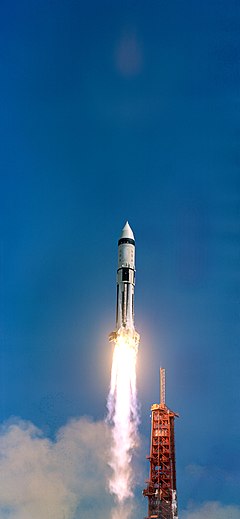 On July 5, 1966, NASA launched Apollo Saturn 203. It was the 6th launch of a Saturn vehicle in preparation for the eventual flight of manned Apollo spacecraft.
On July 5, 1966, NASA launched Apollo Saturn 203. It was the 6th launch of a Saturn vehicle in preparation for the eventual flight of manned Apollo spacecraft.Apollo Saturn 203 (also sometimes informally called Apollo 2) provided the first flight test of restarting the S-IVB upper stage in orbit. This was a key requirement for manned flights to the Moon. The S-IVB was the third stage of the Saturn V rocket. It would first be used to put the Apollo spacecraft into orbit around the Earth while systems were checked out. After everything was confirmed to be okay, the S-IVB would fire again to send the spacecraft en route to the Moon. This was one of the first rocket stages to use liquid hydrogen as fuel. Engineers weren't entirely sure how liquid hydrogen would behave in the fuel tank in weightlessness, so the fuel tank was heavily instrumented for this flight.
 Apollo Saturn 203 launched without an Apollo capsule on top, so its blunted nose looked quite unusual compared to subsequent Apollo flights. The liquid hydrogen fuel behaved as predicted in orbit, and the engine was successfully restarted. The S-IVB was certified as operational and ready to be used with a manned vehicle.
Apollo Saturn 203 launched without an Apollo capsule on top, so its blunted nose looked quite unusual compared to subsequent Apollo flights. The liquid hydrogen fuel behaved as predicted in orbit, and the engine was successfully restarted. The S-IVB was certified as operational and ready to be used with a manned vehicle. Another milestone was passed that would lead to landing men on the Moon just three years later.
